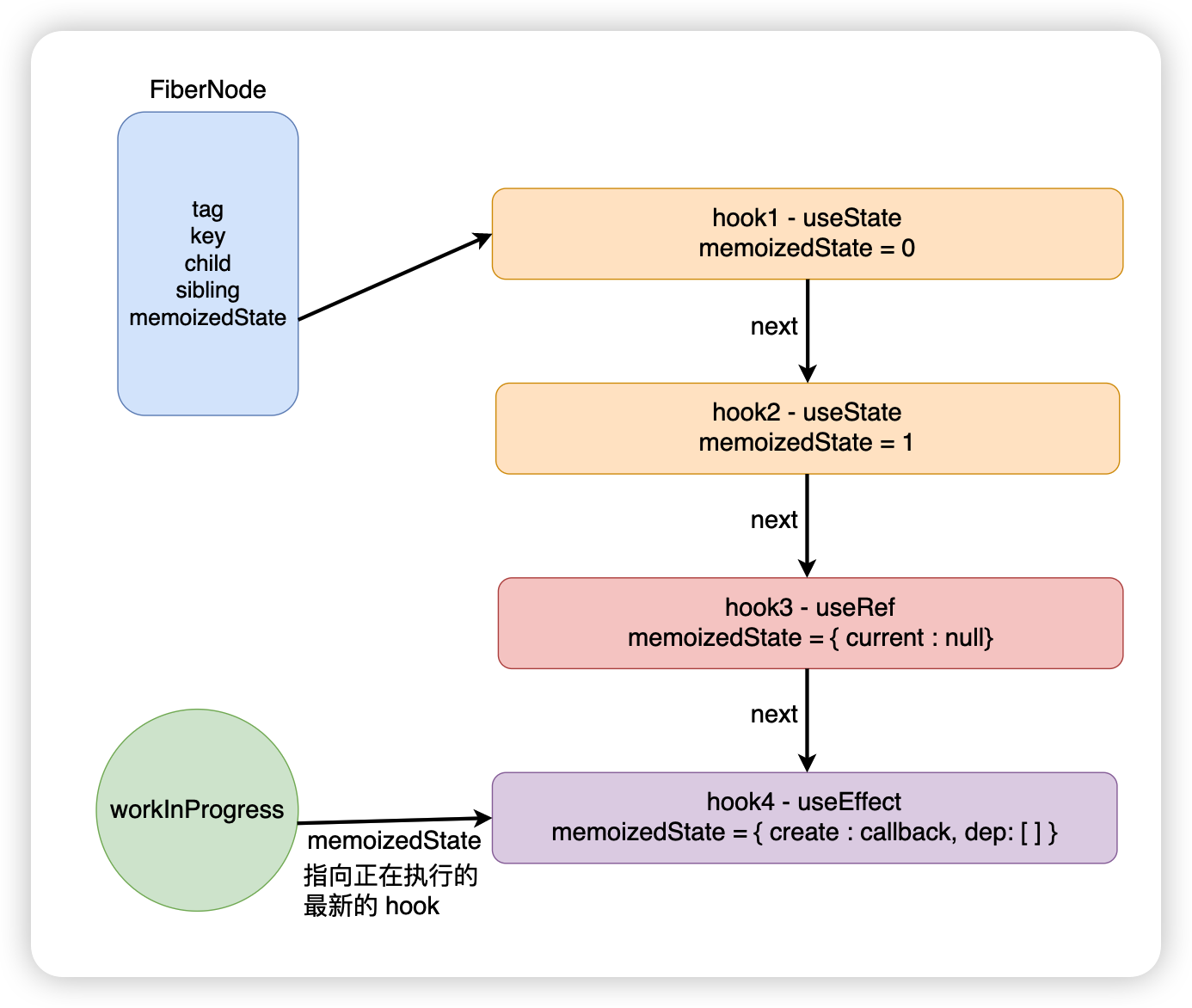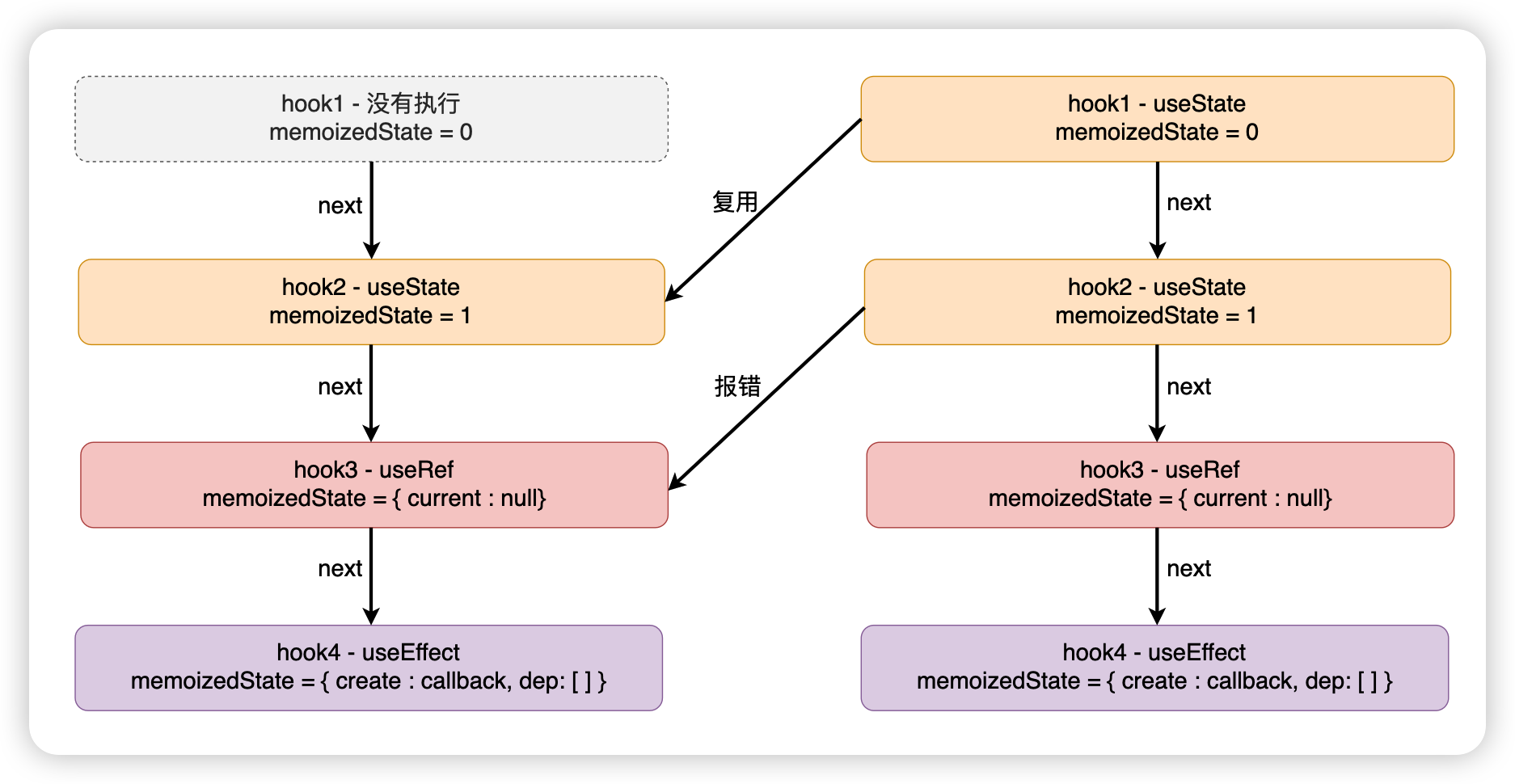Hooks原理
原文地址
/My Passport/渡一6500课程/02 就业提升/06 新React/课件资料/frontend-new-react-master/就业篇/02. 第二章/2-5. React整体架构/课件资料/Hooks原理.md
面试题:Hook是如何保存函数组件状态的?为什么不能在循环,条件或嵌套函数中调用 Hook ?
Hook 内部介绍
在 React 中,针对 Hook 有三种策略,或者说三种类型的 dispatcher:
- HooksDispatcherOnMount:负责初始化工作,让函数组件的一些初始化信息挂载到 Fiber 上面
/* 函数组件初始化用的 hooks */
const HooksDispatcherOnMount: Dispatcher = {
readContext,
...
useCallback: mountCallback,
useEffect: mountEffect,
useMemo: mountMemo,
useReducer: mountReducer,
useRef: mountRef,
useState: mountState,
...
};- HoosDispatcherOnUpdate:函数组件进行更新的时候,会执行该对象所对应的方法。此时 Fiber 上面已经存储了函数组件的相关信息,这些 Hook 需要做的就是去获取或者更新维护这些 FIber 的信息
/* 函数组件更新用的 hooks */
const HooksDispatcherOnUpdate: Dispatcher = {
readContext,
...
useCallback: updateCallback,
useContext: readContext,
useEffect: updateEffect,
useMemo: updateMemo,
useReducer: updateReducer,
useRef: updateRef,
useState: updateState,
...
};- ContextOnlyDispatcher:这个是和报错相关,防止开发者在函数组件外部调用 Hook
/* 当hooks不是函数组件内部调用的时候,调用这个hooks对象下的hooks,所以报错。 */
export const ContextOnlyDispatcher: Dispatcher = {
readContext,
...
useCallback: throwInvalidHookError,
useContext: throwInvalidHookError,
useEffect: throwInvalidHookError,
useMemo: throwInvalidHookError,
useReducer: throwInvalidHookError,
useRef: throwInvalidHookError,
useState: throwInvalidHookError,
...
};总结一下:
- mount 阶段:函数组件是进行初始化,那么此时调用的就是 mountXXX 对应的函数
- update 阶段:函数组件进行状态的更新,调用的就是 updateXXX 对应的函数
- 其他场景下(报错):此时调用的就是 throwInvaildError
当 FC 进入到 render 流程的时候,首先会判断是初次渲染还是更新:
if(current !== null && current.memoizedState !== null) {
// 说明是 update
ReactCurrentDispatcher.current = HooksDispatcherOnUpdate;
} else {
// 说明是 mount
ReactCurrentDispatcher.current = HooksDispatcherOnMount;
}判断了是mount还是update之后,会给 ReactCurrentDispatcher.current 赋值对应的 dispatcher,因为赋值了不同的上下文对象,因此就可以根据不同上下文对象调用不同的方法。
假设有嵌套的 hook:
useEffect(()=>{
useState(0);
})那么此时的上下文对象指向 ContextOnlyDispatcher,最终执行的就是 throwInvalidHookError,抛出错误。
接下来我们来看一下 hook 的一个数据结构
const hook = {
memoizedState: null,
baseState: null,
baseQueue: null,
queue: null,
next: null
}这里需要注意 memoizedState 字段,因为在 FiberNode 上面也有这么一个字段,与 Hook 对象上面的 memoizedState 存储的东西是不一样的:
- FiberNode.memoizedState:保存的是 Hook 链表里面的第一个链表
- hook.memoizedState:某个 hook 自身的数据
不同类型的 hook,hook.memoizedState 所存储的内容也是不同的:
- useState:对于 const [state, updateState] = useState(initialState),memoizedState 保存的是 state 的值
- useReducer:对于 const [state, dispatch] = useReducer(reducer, { } ),memoizedState 保存的是 state 的值
- useEffect:对于 useEffect( callback, [...deps] ),memoizedState 保存的是 callback、[...deps] 等数据
- useRef:对于 useRef(initialValue),memoizedState 保存的是
- useMemo:对于 useMemo( callback, [...deps] ),memoizedState 保存的是 [callback( )、[...deps]] 数据
- useCallback:对于 useCallback( callback, [...deps] ),memoizedState 保存的是 [callback、[...deps]] 数据
有些 Hook 不需要 memoizedState 保存自身数据,比如 useContext。
Hook 的一个执行流程
当 FC 进入到 render 阶段时,会被 renderWithHooks 函数处理执行:
export function renderWithHooks(current, workInProgress, Component, props, secondArg, nextRenderLanes) {
renderLanes = nextRenderLanes;
currentlyRenderingFiber = workInProgress;
// 每一次执行函数组件之前,先清空状态 (用于存放hooks列表)
workInProgress.memoizedState = null;
// 清空状态(用于存放effect list)
workInProgress.updateQueue = null;
// ...
// 判断组件是初始化流程还是更新流程
// 如果初始化用 HooksDispatcherOnMount 对象
// 如果更新用 HooksDispatcherOnUpdate 对象
// 初始化对应的上下文对象,不同的上下文对象对应了一组不同的方法
ReactCurrentDispatcher.current =
current === null || current.memoizedState === null
? HooksDispatcherOnMount
: HooksDispatcherOnUpdate;
// 执行我们真正函数组件,所有的 hooks 将依次执行。
let children = Component(props, secondArg);
// ...
// 判断环境
finishRenderingHooks(current, workInProgress);
return children;
}
function finishRenderingHooks(current, workInProgress) {
// 防止 hooks 在函数组件外部调用,如果调用直接报错
ReactCurrentDispatcher.current = ContextOnlyDispatcher;
// ...
}renderWithHooks 会被每次函数组件触发时(mount、update),该方法就会清空 workInProgress 的 memoizedState 以及 updateQueue,接下来判断该组件究竟是初始化还是更新,为 ReactCurrentDispatcher.current 赋值不同的上下文对象,之后调用
Component 方法来执行函数组件,组件里面所书写的 hook 就会依次执行。
接下来我们来以 useState 为例看一下整个 hook 的执行流程:
function App(){
const [count, setCount] = useState(0);
return <div onClick={()=>setCount(count+1)}>{count}</div>
}接下来就会根据你是 mount 还是 update 调用不同上下文里面所对应的方法。
mount 阶段调用的是 mountState,相关代码如下:
function mountState(initialState) {
// 1. 拿到 hook 对象
const hook = mountWorkInProgressHook();
if (typeof initialState === "function") {
initialState = initialState();
}
// 2. 初始化hook的属性
// 2.1 设置 hook.memoizedState/hook.baseState
hook.memoizedState = hook.baseState = initialState;
const queue = {
pending: null,
lanes: NoLanes,
dispatch: null,
lastRenderedReducer: basicStateReducer,
lastRenderedState: initialState,
};
// 2.2 设置 hook.queue
hook.queue = queue;
// 2.3 设置 hook.dispatch
const dispatch = (queue.dispatch = dispatchSetState.bind(
null,
currentlyRenderingFiber,
queue
));
// 3. 返回[当前状态, dispatch函数]
return [hook.memoizedState, dispatch];
}上面在执行 mountState 的时候,首先调用了 mountWorkInProgressHook,该方法的作用就是创建一个 hook 对象,相关代码如下:
function mountWorkInProgressHook() {
const hook = {
memoizedState: null, // Hook 自身维护的状态
baseState: null,
baseQueue: null,
queue: null, // Hook 自身维护的更新队列
next: null, // next 指向下一个 Hook
};
// 最终 hook 对象是要以链表形式串联起来,因此需要判断当前的 hook 是否是链表的第一个
if (workInProgressHook === null) {
// 如果当前组件的 Hook 链表为空,那么就将刚刚新建的 Hook 作为 Hook 链表的第一个节点(头结点)
// This is the first hook in the list
currentlyRenderingFiber.memoizedState = workInProgressHook = hook;
} else {
// 如果当前组件的 Hook 链表不为空,那么就将刚刚新建的 Hook 添加到 Hook 链表的末尾(作为尾结点)
// Append to the end of the list
workInProgressHook = workInProgressHook.next = hook;
}
return workInProgressHook;
}假设现在我们有如下的一个组件:
function App() {
const [number, setNumber] = React.useState(0); // 第一个hook
const [num, setNum] = React.useState(1); // 第二个hook
const dom = React.useRef(null); // 第三个hook
React.useEffect(() => {
// 第四个hook
console.log(dom.current);
}, []);
return (
<div ref={dom}>
<div onClick={() => setNumber(number + 1)}> {number} </div>
<div onClick={() => setNum(num + 1)}> {num}</div>
</div>
);
}当上面的函数组件第一次进行初始化后,就会形成一个 hook 的链表:

接下来我们来看一下更新,更新的时候会执行 updateXXX 对应的方法,相关的代码如下:
function updateWorkInProgressHook() {
let nextCurrentHook;
if (currentHook === null) {
// 从 alternate 上获取到 fiber 对象
const current = currentlyRenderingFiber.alternate;
if (current !== null) {
// 拿到第一个 hook 对象
nextCurrentHook = current.memoizedState;
} else {
nextCurrentHook = null;
}
} else {
// 拿到下一个 hook
nextCurrentHook = currentHook.next;
}
// 更新 workInProgressHook 的指向
// 让 workInProgressHook 指向最新的 hook
let nextWorkInProgressHook; // 下一个要进行工作的 hook
if (workInProgressHook === null) {
// 当前是第一个,直接从 fiber 上获取第一个 hook
nextWorkInProgressHook = currentlyRenderingFiber.memoizedState;
} else {
// 取链表的下一个 hook
nextWorkInProgressHook = workInProgressHook.next;
}
// nextWorkInProgressHook 指向的是当前要工作的 hook
if (nextWorkInProgressHook !== null) {
// There's already a work-in-progress. Reuse it.
// 进行复用
workInProgressHook = nextWorkInProgressHook;
nextWorkInProgressHook = workInProgressHook.next;
currentHook = nextCurrentHook;
} else {
// Clone from the current hook.
// 进行克隆
if (nextCurrentHook === null) {
const currentFiber = currentlyRenderingFiber.alternate;
if (currentFiber === null) {
// This is the initial render. This branch is reached when the component
// suspends, resumes, then renders an additional hook.
const newHook = {
memoizedState: null,
baseState: null,
baseQueue: null,
queue: null,
next: null,
};
nextCurrentHook = newHook;
} else {
// This is an update. We should always have a current hook.
throw new Error("Rendered more hooks than during the previous render.");
}
}
currentHook = nextCurrentHook;
const newHook = {
memoizedState: currentHook.memoizedState,
baseState: currentHook.baseState,
baseQueue: currentHook.baseQueue,
queue: currentHook.queue,
next: null,
};
// 之后的操作和 mount 时候一样
if (workInProgressHook === null) {
// This is the first hook in the list.
currentlyRenderingFiber.memoizedState = workInProgressHook = newHook;
} else {
// Append to the end of the list.
workInProgressHook = workInProgressHook.next = newHook;
}
}
return workInProgressHook;
}在上面的源码中,有一个非常关键的信息:
// ...
if (nextWorkInProgressHook !== null) {
// There's already a work-in-progress. Reuse it.
// 进行复用
workInProgressHook = nextWorkInProgressHook;
nextWorkInProgressHook = workInProgressHook.next;
currentHook = nextCurrentHook;
}
// ...这里如果 nextWorkInProgressHook 不为 null,那么就会复用之前的 hook,这里其实也就解释了为什么 hook 不能放在条件或者循环语句里面
面试题:hook 为什么通常放在顶部,而且不能写在条件或者循环语句里面?
因为更新的过程中,如果通过 if 条件增加或者删除了 hook,那么在复用的时候,就会产生当前hook 的顺序和之前 hook 的顺序不一致的问题。
例如,我们将上面的代码进行修改:
function App({ showNumber }) {
let number, setNumber
showNumber && ([ number,setNumber ] = React.useState(0)) // 第一个hooks
const [num, setNum] = React.useState(1); // 第二个hook
const dom = React.useRef(null); // 第三个hook
React.useEffect(() => {
// 第四个hook
console.log(dom.current);
}, []);
return (
<div ref={dom}>
<div onClick={() => setNumber(number + 1)}> {number} </div>
<div onClick={() => setNum(num + 1)}> {num}</div>
</div>
);
}假设第一次父组件传递过来的 showNumber 为 true,此时就会渲染第一个 hook,第二次渲染的时候,假设父组件传递过来的是 false,那么第一个 hook 就不会执行,那么逻辑就会变得如下表所示:
| hook 链表顺序 | 第一次 | 第二次 |
|---|---|---|
| 第一个 hook | useState | useState |
| 第二个 hook | useState | useRef |
那么此时在进行复用的时候就会报错:

第二次复用的时候,发现 hook 的类型不同, useState !==useRef,那么就会直接报错。因此开发的时候一定要注意 hook 顺序的一致性。

真题解答
题目:Hook是如何保存函数组件状态的?为什么不能在循环,条件或嵌套函数中调用 Hook ?
首先 Hook 是一个对象,大致有如下的结构:
jsconst hook = { memoizedState: null, baseState: null, baseQueue: null, queue: null, next: null }不同类型的 hook,hook 的 memoizedState 中保存了不同的值,例如:
- useState:对于 const [state, updateState] = useState(initialState),memoizedState 保存的是 state 的值
- useEffect:对于 useEffect( callback, [...deps] ),memoizedState 保存的是 callback、[...deps] 等数据
一个组件中的 hook 会以链表的形式串起来,FiberNode 的 memoizedState 中保存了 Hooks 链表中的第一个 Hook
在更新时,会复用之前的 Hook,如果通过 if 条件语句,增加或者删除 hooks,在复用 hooks 过程中,会产生复用 hooks 状态和当前 hooks 不一致的问题。
